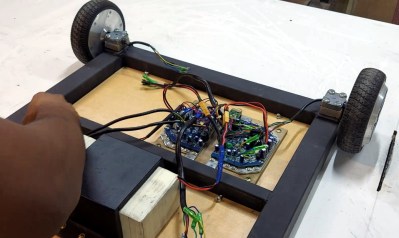Twister, the mildly embarrassing but strangely enjoyable floor contortion game that most of us have vague youthful memories of from Christmas parties. Could a Twister mat be used as an input device? [Guy Dupont] took those 24 coloured dots and made just that, after a conversation with a friend.
Wiring up a floor-sized plastic mat isn’t as easy as it might seem, and early experiments with copper foil and capacitive touch sensor chips proved to be a failure. The replacement came in the form of force sensitive resistors, read by a brace of MCP3008 multiplexed analogue-to-digital converters. These are then read by an ESP32 that does all the MIDI magic. We’re treated in the video below the break to full details including the entertaining sight of him playing Twister to a beat, prompted by a robotic-voiced random move generator, and we can see that this devices has some potential.
We’ve not seen another Twister mat before, but force sensitive resistors have made an appearance in a much higher-resolution array. It’s the LED floor game controller that has us going though.



















